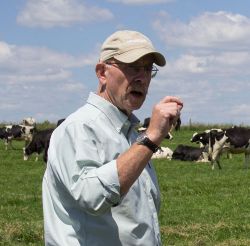
Perhaps that’s the case or perhaps not; however, it’s most certainly not true if you have your sights set on something north of “good.” Without question, most of today’s nutritionists and dairy producers run with this latter crowd.
As we look back, the road to excellent corn silage has come a long way in a relatively short period of time. When I started my career as an extension agronomist in the late 1980s, the recipe for corn silage was obscenely simple: Pick a good grain hybrid and have at it.
As corn silage gained popularity, seed companies began evaluating hybrid lines for silage performance. It soon became clear that there were both yield and quality differences among hybrids. Some universities added silage performance testing to their traditional grain hybrid trials. There was also a noticeable spike in silage feeding trials.
During the ensuing years, corn breeders developed “silage specific” hybrids, some of these had designer traits such as more leaves; others were conventional but excelled in silage yield and/or quality. Cargill introduced its first brown midrib (BMR) hybrid during the mid-1990s.
In addition to advancements in plant breeding, it was soon discovered that kernel processing could drastically improve animal utilization of corn silage. This innovation took hold in the late 1990s and early 2000s. At first, the processors had to be retrofitted onto existing forage harvesters (mostly pull type), but it wasn’t long before machinery companies offered this option on new machines.
At first, kernel processors were deemed effective if they simply cracked or “nicked” the kernel, allowing rumen bugs a “door” to digestion.
In 2005, Dave Mertens of the USDA Dairy Forage Research Center developed an approach to estimate how well corn grain was processed within corn silage. The measure, termed kernel processing score or KPS, has since grown in popularity and is held as the standard to evaluate silage processing performance with an ultimate goal of 70 percent or above.
Both silage hybrids and kernel processors have continued to improve over the years. Design features and larger roll-speed differentials have made exceptional kernel processing possible on all new choppers and result in less starch going out on the manure spreader.
A third game changer in the corn silage world has come from the discovery that feed quality improves with time in storage.
This core finding, which has been confirmed in multiple research trials, has led to the recommendation that enough additional storage is needed to prevent recently harvested silage from being fed. Often, the suggestion is for three to four months of carry-over inventory.
The improvement in corn silage quality during a period of up to at least eight months in storage comes primarily in the form of enhanced starched digestibility and also a higher KPS, often 5 to 10 percentage units higher. To be clear, there is no improvement in fiber digestibility. The magnitude of improved starch digestibility over time is often associated with the moisture content at harvest.
The corn silage story is far from over. High-cut corn silage is becoming popular as a means to improve fiber digestibility and raise the starch content. There will no doubt be better hybrids in the future and improved machinery for which to get it harvested. “Good” corn silage is no longer a reasonable benchmark for high-producing dairy herds. These days, technology allows us to easily do much better.
This article appeared in the August/September 2019 issue of Hay & Forage Grower on page 4.
Not a subscriber? Click to get the print magazine.

